A brief post for this Sunday, with a visit to a stunning building that is almost all that remains of one of London’s early hospitals. This is the chapel of the old Middlesex Hospital, now known as the Fitzrovia Chapel.
Turn off Tottenham Court Road into Goodge Street, then cross over to where it becomes Mortimer Street, and a short distance along is this rather bland entrance to a recent development – Fitzroy Place.
This is the site of the old Middlesex Hospital, now occupied by a development of apartments, restaurants and office space. There is one main survivor of the hospital, located at the core of the new development that is well worth a visit. This is the chapel of the Middlesex Hospital, now known as the Fitzrovia Chapel. Located in a central square, partly behind a row of trees is the brick built chapel, looking very different from the buildings that now surround.
The exterior of the Fitzrovia Chapel is relatively plain, constructed mainly of red brick with very little in the way of exterior decoration, but step inside the building and a very different experience awaits.
Looking along the nave of the chapel towards the altar (behind the TV screen), and the chancel.
Looking up at the decoration of the chapel.
The interior decoration of the chapel is the complete opposite to the exterior. Colour and decoration cover almost every surface.
The Fitzrovia Chapel is of relatively recent construction. Dating from 1891, with the interior decoration completed by 1929, although the origins of the Middlesex Hospital of which the chapel was part, date back to the 1740s.
The chapel was commissioned by the governors of the hospital in the 1880s as a memorial to Major Alexander Henry Ross, MP who had been Chairman of the Board of hospital governors for 21 years. The architect was John Loughborough Pearson who used a background in Gothic religious architecture to his design for the Middlesex Hospital Chapel. He would not live to see the chapel completed as he died in 1897, however work on the chapel was continued by his son, Frank Loughborough Pearson, and the chapel was finally completed in 1929.
One of the reasons for the length of time it took to complete the chapel was that a commitment was made that no money meant for patient care would be used for the chapel, so as well as the time needed for building and the complex decoration, it was also the time needed to collect sufficient donations to finish such as beautiful building.
The vaulted roof of the chapel is decorated with stars against a stunning gold background with bands of decoration meeting at the centre.
Another view of the roof.
Stained glass windows add to the impression of a religious building, which indeed it is, however the chapel was not consecrated (there was no legal Deed of Consecration), but was dedicated by the Archbishop of Canterbury in February 1939, who described the building as “without question one of the most beautiful hospital chapels in the realm”.
A weekly service held in the chapel was relayed across the hospital to patients.
The chapel was used for many different purposes over the years. Services, concerts by touring choirs, funerals, however one of the more unusual was probably after the death of Rudyard Kipling at the Middlesex Hospital in January 1936. Kipling, who was described in newspaper reports of the time as the “poet of the British Empire”, was taken to the chapel, where his coffin, draped in a Union Jack, was placed before the altar. A bunch of violets were placed on the coffin. These had been sent by Mrs Baldwin, the wife of the Prime Minister. His body was later cremated and his ashes interred in Westminster Abbey.
Since the original establishment of the Middlesex Hospital, the hospital buildings have been through a number of waves of extension and rebuilding, and the last major rebuild was at the time when the chapel was completed, when virtually the whole of the hospital was rebuilt during the late 1920s and early 1930s.
Either side of the entrance to the nave of the chapel is an apse. The south-west apse is decorated in rich blue and golds.
Which provides space for a font, built from a solid block of deep green marble.
The north-west apse includes a roundel of Saint Barnabas just below the vaulted roof.
The organ gallery above the main entrance to the nave.
The vestibule between the entrance to the chapel and the nave is lined with plaques recording the names of those who donated towards the costs of the chapel, eminent hospital staff, as well as hospital staff who died on duty, including nurses such Dorothy Adams, Maudie Mason, and Grace Briscoe who died from influenza and scarlet fever in 1919.
There are also plaques commemorating John and Frank Loughborough Pearson, the architects of the chapel.
The central square of Fitzroy Place, in which the chapel is located, is called Pearson Square, after the architect(s) of the chapel.
From the 1980s onward, the functions of the Middlesex Hospital were gradually relocated to other London hospitals, with final closure of the site in 2005 when the remaining services were moved to University College Hospital.
The site was sold off for private development, and with the exception of the chapel which was Grade II listed, the entire hospital was demolished in 2008, leaving a large expanse of land with the chapel at the centre. The financial crash of 2008 delayed redevelopment of the site, which was finally commenced in 2011.
As with any large development in London during the last few decades, development included going down as well as up, and the space for four floors of car parking and other facilities was excavated around the chapel, which was underpinned and supported on piers to protect the structure of the chapel.
A condition of Westminster City Council’s planning permission for the overall site was that the developers would fund the restoration of the chapel, which had deteriorated as the hospital gradually contracted and closed. Following restoration, the chapel opened in 2015, having also been transferred to an independent charitable foundation, the Fitzrovia Chapel Foundation to maintain, preserve and run the chapel. It is now open for public viewing on Wednesday’s, as well as being available for hire for secular wedding ceremonies (I assume because the chapel was dedicated rather than consecrated), exhibition space, private functions etc.
At the time of redevelopment of the site and restoration of the chapel, there was a campaign to retain the name of the Middlesex Hospital Chapel, however this original name probably did not fit with the developer’s intentions for the branding of the new development. The Middlesex Hospital Chapel became the Fitzrovia Chapel to reflect the wider area of Fitzrovia, rather than the old hospital.
I am no expert, but it does seem a trend of the last few decades where public institutions are gradually dispersed allowing a central site to be closed and sold off. Middlesex Hospital had been in operation for over two hundred years and had built up a long tradition of expertise, team work and institutional memory – things which take many years to develop, but are quickly lost and almost impossible to replace.
The Fitzrovia Chapel is all that is left to recall the hospital that once occupied the wider site for over two hundred years. Although it has a new name, hopefully, it will always be the Middlesex Hospital Chapel.

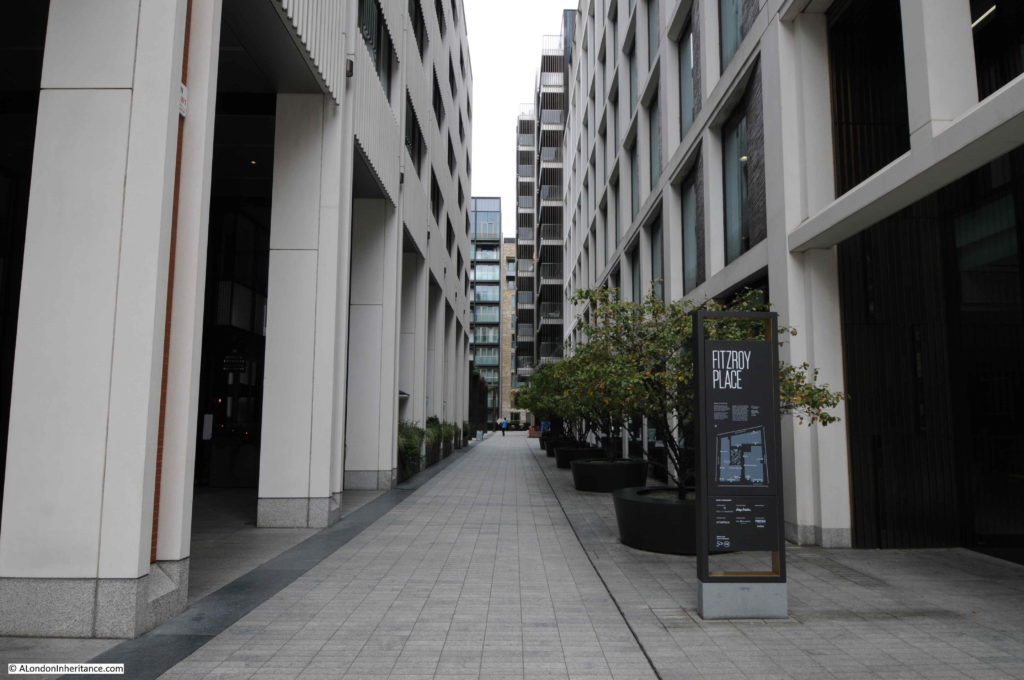
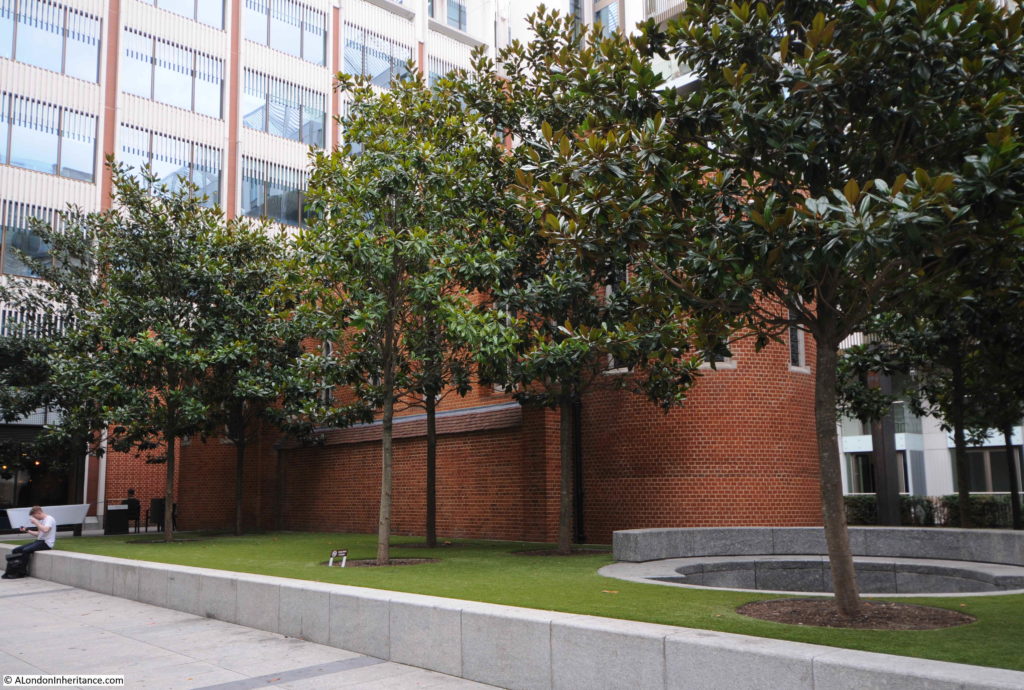

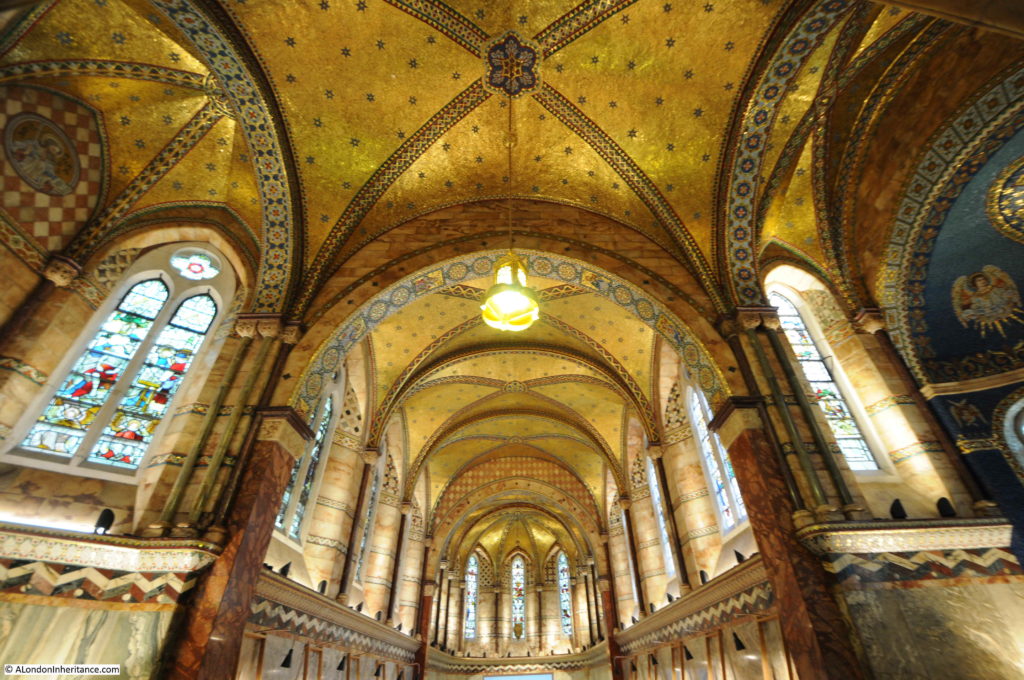
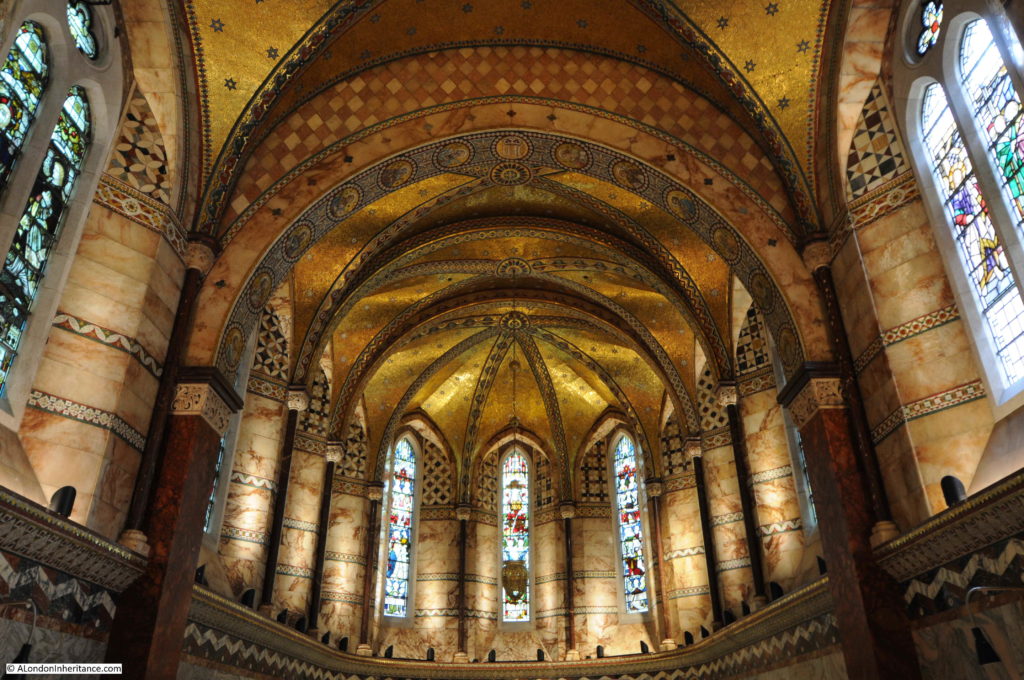
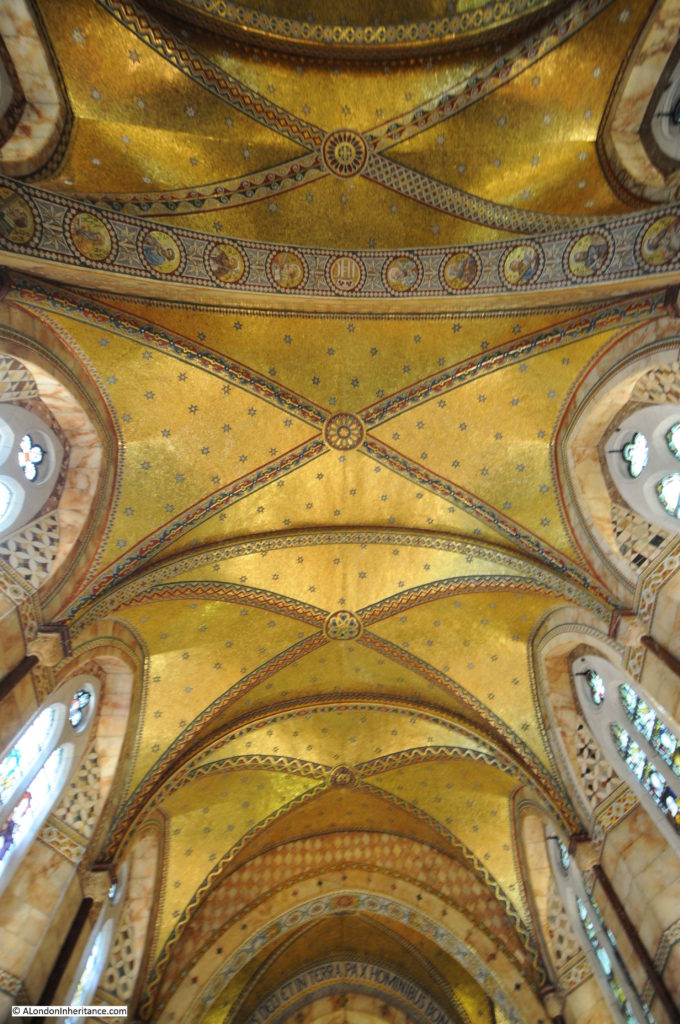
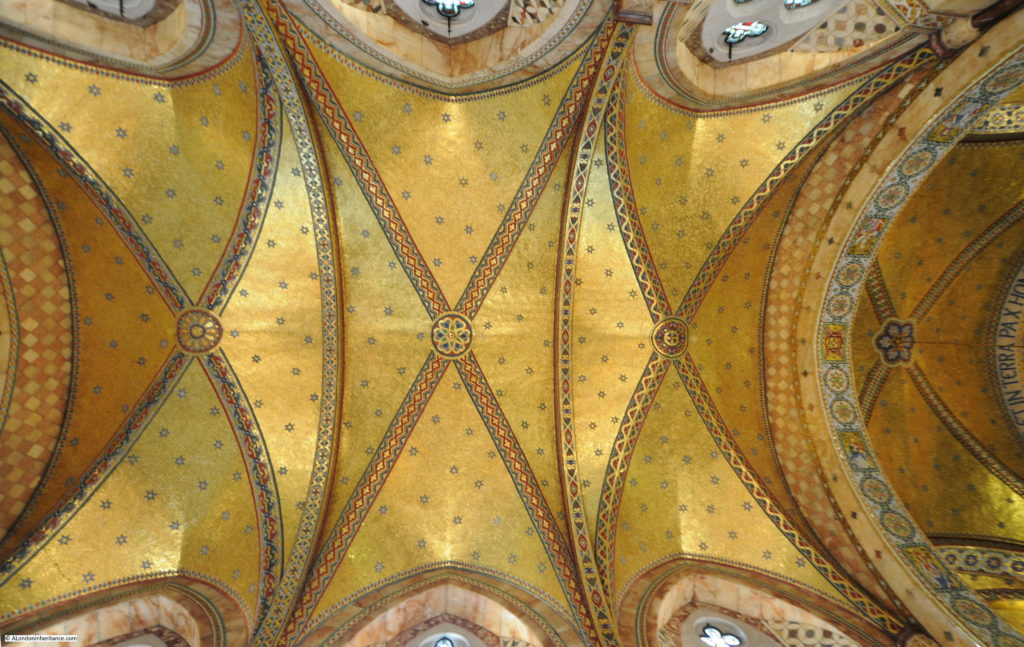

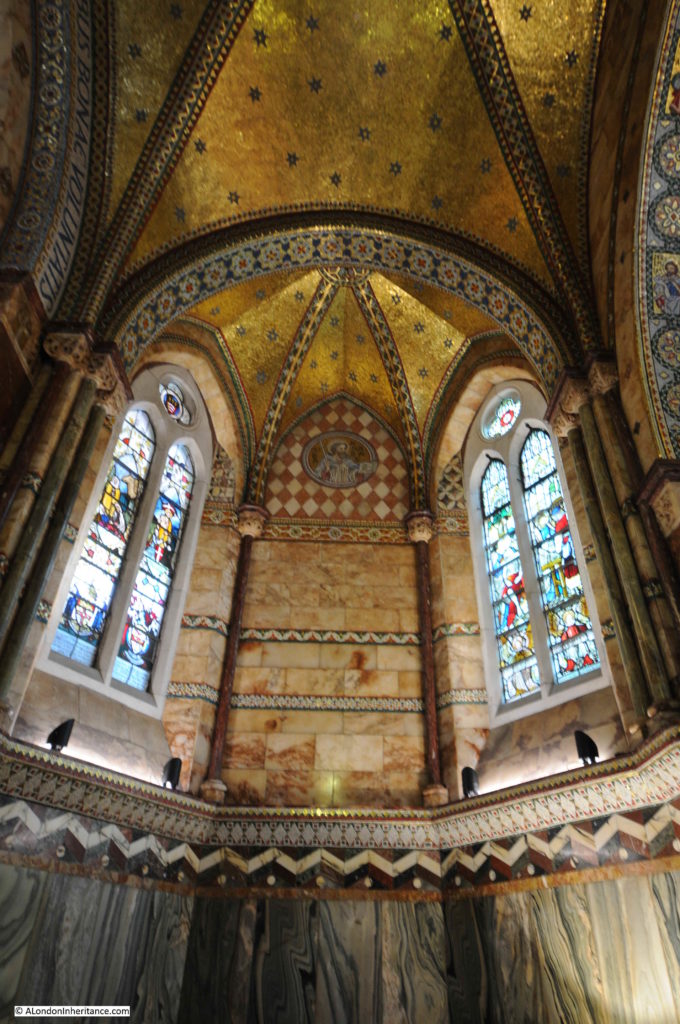



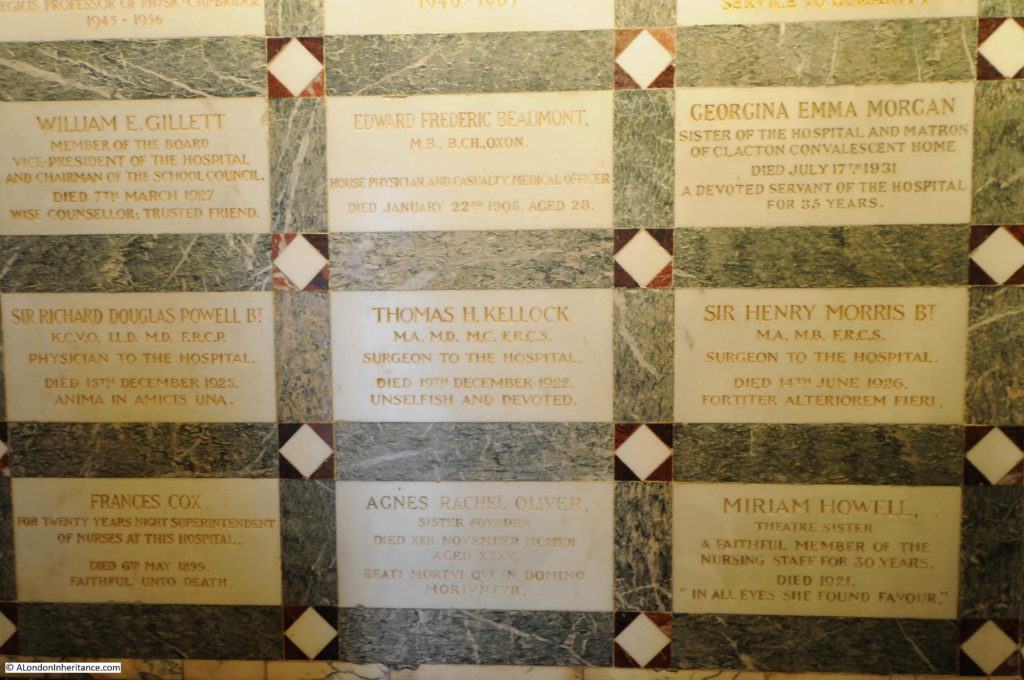

The irony of a TV screen in front of the altar, a real sign of the times!
Happy New Year to you – I’m looking forward to more superb content!
That was interesting. I worked there as a medical secretary for a while in 1984 and recall sitting in the central gardens of the hospital in my lunch hours. What a shame I didn’t notice the chapel and poke my nose in. It was a strange hospital in the centre of London, a bit ramshackle and always seemed very dark but I missed it when it went. Beautiful wall paintings in the main entrance too.
A new door has been cut in the entrance in order to connect to a restaurant adjacent. It’s a window I think, cut down.
Great article on Middlesex Hospital Chapel. Far too much of old London has been and is being knocked down. Once it’s gone, it’s gone. Token buildings are retained, dotted around the capital. No old quarter, no effective conservation policy.
After the hospital was demolished, and the site was being prepared for redevelopment, I went past on the upper deck of a bus. Being able to see clearly over the barriers around the site, you could see the foundations for what was to come being dug out – clearly the old basements of the hospital went down a fair way. And there, on a pillar of earth amidst the great excavations, was the chapel, looking like one of those Chinese “Nail Houses”. Extraordinary.
An amazing building.
Thanks for another year of spectacular discoveries. Your insight and commitment are special and really appreciated. Your father would be so proud that you carry the tradition so well!!
Paul in Glasgow.(ex-London resident)
…what a wonderful post to read on a Sunday morning.
All the best for 2020 to one and all
I used to volunteer at the Middlesex in the 1970s – before it was absorbed into the UCL Hospitals group and it still had an independent medical school. But even then it was clear that the hospital was not sustainable in the modern world. It was small by modern standards, split over many buildings in Fitzrovia, and clearly more sensible to redeveloped UCH on a new site on the Euston Road, and combine it with the Middlesex.
The chapel is not the only surviving building from of the old Middlesex Hospital. The former Strand Union Workhouse on Cleveland St was the Middlesex Outpatients’ Department, and still stands. It is much older than the chapel (built in the 1770s) and is listed Grade II (https://historicengland.org.uk/listing/the-list/list-entry/1242917 and https://en.wikipedia.org/wiki/Cleveland_Street_Workhouse).
When the site was being redeveloped, I was visiting the top of the BT (ex Post Office) Tower – and it was strange to look down on this square of rubble, with the chapel left standing in the middle. I probably have a photograph somewhere in my phone’s memory
I used to go to the Middlesex Hospital, at the end of the 70s, to have treatment on my teeth. I enjoyed going there, because it meant a day off school, and after my appointment, I’d have a wander along Tottenham Court Road, browsing Habitat’s and Heal’s!
I never knew about this chapel, what a hidden jewel. It looks so plain on the outside, giving no clue to the wonder that’s within. I’m so glad it wasn’t demolished along with the hospital.
London is losing all it’s character. Other cities manage to keep whole areas as they were, but London just bulldozes everything in it’s path, in a hurry to put up steel and glass monstrosities. It’s so sad to see my birthplace changing so drastically.
Thanks for your posts throughout the year, I always enjoy reading them on a Sunday morning. I look forward to more in 2020, and wish you a happy New Year.
I worked at the Middlesex Hospital in the mid 1970s as a Secretary/PA in the Personnel (HR) Department. Our offices were in a house in Nassau Street and overlooked the entrance to the A&E Department. We used this entrance to collect our work and visitors to Personnel from the main area of the hospital. The route took us past the chapel and I occasionally went in to admire it, but always felt I should not really be there as it was for the patients and their visitors who I had occasionally seen sitting in there.
I also remember a very large black plaque in the entrance stating that money to start the hospital had been raised voluntarily from army personnel.
Thank you for your posts each week and look I forward to 2020 and more fascinating information.
This week’s article and comments such as the above are an excellent reminder that the streets of Fitzrovia make a very pleasant stroll with delights such as the Chapel to be sought on the way.
Noted on such a stroll recently:
Surprisingly the Middx Hospital brick and stone frontage in Nassau Street has been preserved, though all is new behind the facade. The retention wraps around into Mortimer Street but doesn’t quite make it to Riding House Street at the rear.
The warm brick colours make Nassau Street attractive especially in sunlight, though it should be said that “facadism” isn’t everyone’s cup of tea.
Sculpted letters above eye level in the street still report “Middlesex Hospital Radium Wing”, “Meyerstein Institute of Radio-Therapy” and a plaque noting funds bequeathed by the late Henry I. Barnato.
Next time I’ll make sure to visit the area on a Wednesday.
Looking forward to more reads on the wonders of London.
Thanks again for an always interesting article. Am far away in San Diego California but love your London stories.
Thanks as always. By the way Kipling and Baldwin were first cousins His Unvle was the Pre-Raphaelite painter Burne-Jones.
Hi, recently went to an Arts Society lecture on Burne Jones. Born and raised in Birmingham. Married Georgiana whom he met at school. One of her sisters was the mother of the politician and then PM Stanley Baldwin, another married Rudyard Kipling.
Thank you for another very interesting article on the City I love. I was born in the Middlesex hospital way back in 1938. I always meant to revisit it but sadly I am too late. After reading about the hospital chapel and readers comments, I am now determined to put it top of my bucket list for early in the New Year! Thank you so much for your very interesting articles, I look forward to reading them every week. I attended an Adult Education class for twenty years on the history of London. We had a lecture one week, then on the alternate week we would visit different buildings and areas of London. There is so much to see and learn. Thank you so much for your posts, and very best wishes for a Happy New Year.
Thank you for this very interesting piece and lovely photos. That’s going on our ‘must see’ list for our next visit to London (from Australia).
I wandered past there a couple of weeks back. I should have gone inside. That’s really rather wonderful.
I was a staff nurse / sister in ITU at the Middlesex in the late 70’s early 80’s. Shamefully, I remember the chapel being there but have little memory of being in it. What a gem I missed; made even more meaningful by the insights into the history behind it. The lighting in the photographs highlight the details which may have been barely visible then, especially when I was so unaware of what I was looking at.
Thank you for very interesting article. It has brought a host of happy memories back about the dear old Middlesex. The Chapel will be a first port of call on my next visit to London.
Thanks for a very interesting article. The site looks a bit different from when I took this photo from the BT Tower in September 2011
https://flic.kr/p/2i7shrS
A little jewell indeed very evocative picture from telecom tower-happy new year look forward to next years offering.
I was a student nurse at the Middlesex Hospital and lived in the nurses home on Foley Street! 1989-1992
My then boyfriend, could only exit the nurses home via the tunnels that went all the way to the casualty!
It was a brilliant lovely hospital!
An excellent and helpful article. Thank you.
I am with others studying the Chapel to make a record of the stained glass and the dedicatees.
I am a graduate of The Middlesex Hospital Medical School in 1962 and would really like to be in touch with you.
So interesting to read your article on my old training hospital. I have always been so proud and feel very privileged to have been part of this hospital The Middlesex Hospital (November ’59-’63). Now nearing 80yrs, I still benefit from those years of discipline!
I’m afraid that I find the re-naming of The Middlesex Hospital Chapel as the Fitzrovia Chapel an insult to over 200 years patient care by Doctors, Nurses, Porters , Chefs, Chaplains and every other worker at the hospital, and to the patients and their relatives who found some peace and consolation in its atmosphere! And yes, I trained there in the sixties and am still proud of having done so.
My daughter was in the Middlesex hospital for 5 months when she was 18 months old in 1968. In those days one could not stay at hospitals with children so I used to travel up almost every day. I will always be grateful to the wonderful doctors and nurses that saved her life and cared for her. It was a first class hospital and if I remember there was a beautiful mural at the entrance picturing nurses. Was this made up of tiles. I can’t remember. I can’t recall seeing this beautiful Chapel or not, it seems so long ago, but I will make a point of visiting it when it reopens again. I was watching the news on BBC this morning and it showed parts of it in a programme about aids. That’s how I found out about it and then I googled it.
A veritable jewel!
A reminder of the dedication and skill of Middlesex staff of all disciplines.
We have much to be grateful for.
An enduring memorial to NHS personnel who’s professionalism and dedication have seen us through the pandemic?
I was born in the Middlesex Hospital in 1963 and have just found your blog post on the Fitzrovia Chapel. I have often wondered where ‘Fitzrovia’ actually was, as it seemed to be a new area that popped up in the centre of London, that was a mystery to me! Now I know. Thank you to all the doctors, nurses, midwives and staff past, who worked in the Hospital during g it’s time. I will visit at the next opportunity to see this beautiful little piece of history and a reminder of somewhere that has been white washed in a physical sense, from history. Thank you.
It is good to hear The Middlesex Hospital remembered.
It was indeed a special place, strong feelings of loyalty persist among Middlesex alumni, – a diminishing band.
The chapel is open on Wednesdays – it is worth a visit, both to admire this jewel and to reflect on the words as you enter:
‘Dedicated to the glory of God and in memory of those faithful servants of the hospital who…. have died …or devoted their time and energies.’
Angela.
Former Middlesex nurse.
The chapel will be remembered for many reasons by both staff and patients. It was the still, quiet place at the centre of a very busy hospital. I visited it many times whilst working at the hospital to take a break from a difficult shift or give thanks when things were going well. I am glad that the chapel was preserved and hope to visit next time I am in London.
It is great to hear of past members of staff visiting the hospital chapel. Whenever I am in there I encounter former Middlesex people who come from all quarters of the globe, it is surprising how many cherish their memories of working in the hospital.
Angela
I trained as a nurse (1956-60) at The Middlesx and remember the chapel well. Each Sunday Holy Communion was celebrated at 6.30 a.m. to fit in with 7.30 a.m on duty, and a non-denominational service at 8.30 p.m following 8 p.m duty finish time.
I was a member of the choral society and a few of us sang in the chapel loft for the patients’ Christmas carol service. In 1959 I was asked by Matron Marriot to be The Virgin Mary for the tableau/play that was part of the service. I had a real newborn baby handed to me for the primary role; his/her mother was in the back pew in a dressing gown with tears in her eyes. I will never forget it.
Yes it is a beautiful chapel.
In April 2023 A Record of the stained glass and other artefacts in the chapel was launched.
It can be seen at:
https://themiddlesexhospital.london/wp-content/uploads/2023/06/Fitzrovia-Chapel-record-stained-glass-other-artefacts-v1.pdf